
For a business to successfully change its processes to meet customer needs and expectations, it must use measurable critical-to-satisfaction data. One company, a homebuilding business, used customer satisfaction surveys to measure performance for several years with customers receiving surveys periodically throughout their homebuilding experience. Then the company used this information to implement change.
Data collected from the homebuilder’s surveys showed that, while customer satisfaction scores during each of the early phases of the experience improved slightly from year to year, the overall customer satisfaction rating for the final survey (one-year from initial ownership) dropped from 86 points to 82 points from 2002 to 2003 (Figure 1).
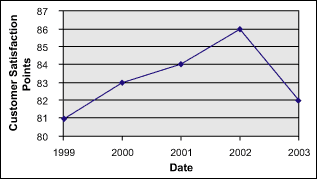
The company analyzed the survey results to determine which processes were contributing most to customer dissatisfaction. They determined that 53 percent were caused by three processes – warranty, lending and workmanship (Figure 2).
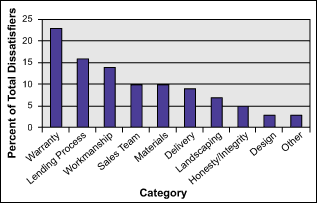
Expanding the root cause analysis to look more closely at each of these processes enabled the business to understand where to focus in order to improve customer satisfaction. Further analysis of the warranty process showed that the top three items – inconvenient, more visits and scheduling – represented 74 percent of the dissatisfaction scores for that process (Figure 3).
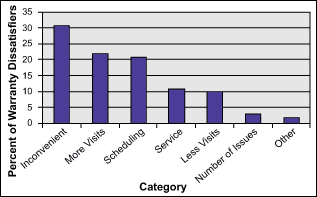
A Six Sigma project team was created to improve the warranty process. The team included employees who performed the warranty work, customer care representatives who managed the work and building supervisors who checked and inspected the work. The team’s first step was to map the warranty process in its current state (Figure 4).
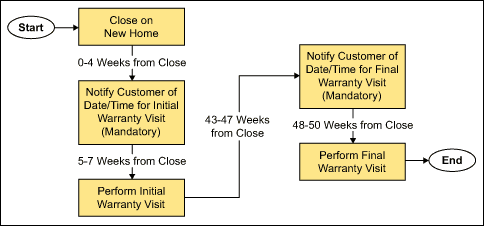
Next, the team reviewed customer survey scores for the warranty process and developed a Critical-to-Satisfaction (CTS) tree to convert customer needs and wants into measurable requirements. Using the CTS tree, the team was able to identify seven opportunities for improvement to the existing process to address the customer dissatisfaction issues (Figure 5).
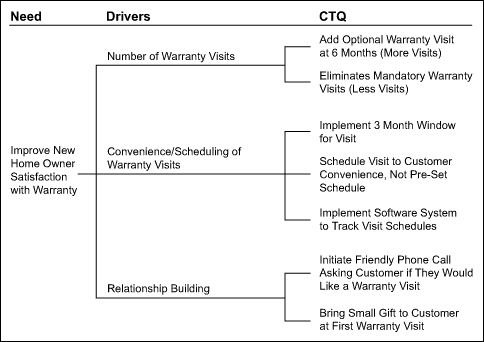
Once the improvement opportunities were identified, the team created a future state process map reflecting the anticipated changes. Relying on the CTS tree to identify gaps between the voice of the customer and the voice of the process, the team was able to address the root causes of customer dissatisfaction (Figure 6).
The improvements included:
- Eliminating mandatory warranty visits, making all warranty visits optional. This change satisfied customers who thought there were too many visits as well as those who felt there were not enough.
- Offering a three-month window rather than the existing two-week window to schedule warranty visits. This change eliminated the inconvenience for customers who had busy schedules and found it difficult to work within the original timeframe.
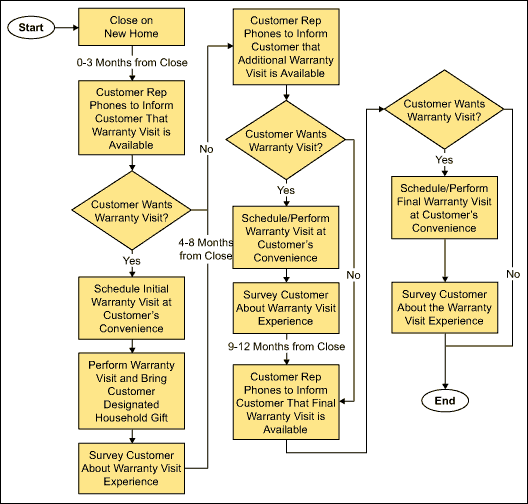
Frequent surveys regarding the warranty visit experience helped ensure the company was continually aware of customer needs throughout the first year of new home ownership. The relationship aspects of the new process (a pleasant phone call from customer representative, no pressure to schedule, no mandatory visits, small household gift presented at first warranty visit) were intended to build a congenial relationship between the employees performing the warranty work and the customer.
The Six Sigma team took a general, difficult-to-measure need (to improve homeowner warranty satisfaction) and developed and implemented specific, measurable and actionable steps to drive improvements in customer satisfaction. The company listened to the customer and changed the process accordingly.